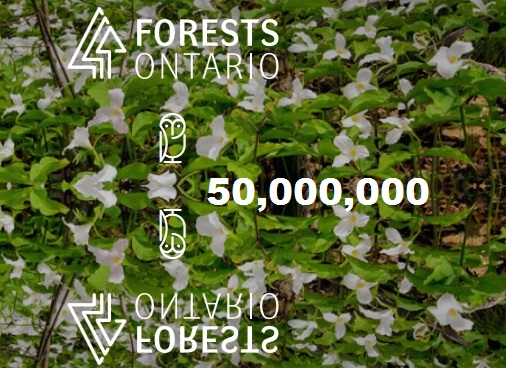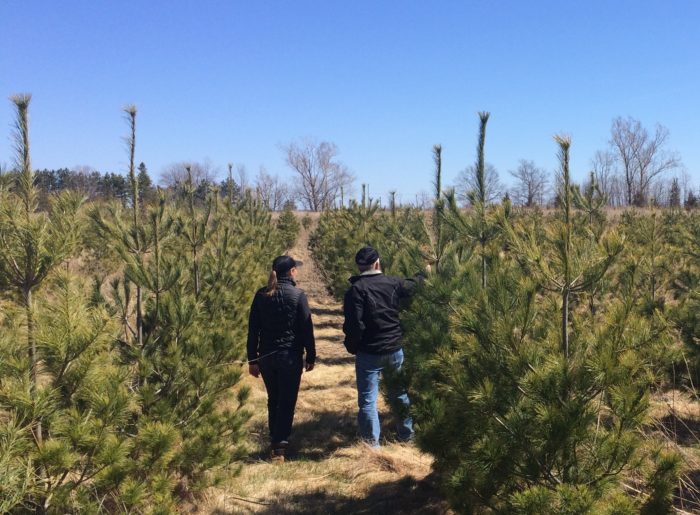 Spring is for new ideas. Do you have idle land or extra acreage that could be enhanced? Planting trees is an excellent way to add value to your property and has never been easier. If you have 2.5 acres or more of open land, you may be eligible for the 50 Million Tree Program, and the trees are planted for you!
Spring is for new ideas. Do you have idle land or extra acreage that could be enhanced? Planting trees is an excellent way to add value to your property and has never been easier. If you have 2.5 acres or more of open land, you may be eligible for the 50 Million Tree Program, and the trees are planted for you!
If you are considering a large-scale planting on your property, the 50 Million Tree Program can help by providing both funding support to cover a significant portion (up to 80%) of the total planting costs and technical assistance. A local planting partner will work with you to develop a site plan that suits your property’s unique needs; they will do the planting and conduct follow up assessments in subsequent years. The landowner can relax while the work is conducted by experienced professionals.

“One of the great things about the 50 Million Tree Program is that it’s full service. Landowners work with the Planting Delivery Agencies (PDA) to develop the plan and choose the species of trees being planted on the property,” explains Mark McDermid, a Field Advisor at Forests Ontario. “The PDAs – forestry professionals – are responsible for the purchase, delivery and planting of all trees in the program.”
The 50 Million Tree Program plants for landowners who want to make their property more aesthetically pleasing, for farmers who have an idle field or want a windbreak, and for golf course owners who want to add some shade. Every landowner has a different vision so the planting agents work with you to make sure that vision becomes a reality.
The 50 Million Tree Program makes tree planting as easy as possible for landowners in Ontario. To book a site visit, contact Suzanne Perry, our Forestry Outreach Coordinator at 1-877-646-1193 or sperry@forestsontario.ca. Please mention thesilo.ca when contacting.
About 50 Million Tree Program
Forests Ontario administers the Ontario government’s 50 Million Tree Program, part of the United Nations Billion Tree Campaign. The United Nations’ goal is to plant one billion trees worldwide each year. Ontario is committed to plant 50 million trees by 2025.
The 50 Million Tree Program is designed to significantly reduce the costs to landowners of large-scale tree planting and thereby increase the number of trees planted across the province.
 About Forests Ontario
About Forests Ontario
Forests Ontario is the voice for our forests. Working to promote a future of healthy forests sustaining healthy people, Forests Ontario is committed to the re-greening of Ontario through tree planting efforts on rural lands and in urban areas, as well as the renewal and stewardship of Ontario’s forests through restoration, education and awareness. Visit www.forestsontario.ca or follow us @Forests_Ontario.

Alternative Land Use Bill Passes Second Reading
The Ontario Legislature recently debated and voted in favor of a bill to support the concept of setting aside land for wildlife and other environmental purposes.
In addition to support from all political parties, the Private Member’s Bill – which I authored – received support ranging from Delta Waterfowl to the World Wildlife Fund; from the Ontario Federation of Anglers and Hunters to Ontario Nature, the Ontario Home Builders Association, the Insurance Bureau of Canada, and all three of Ontario’s general farm organizations.
This proposed legislation recognizes the right of farmers and other landowners to voluntarily set aside any part of that land as fallow for either of the following two purposes: to establish, restore or preserve a natural ecosystem; and to establish and maintain projects that produce services for natural ecosystems.
Following second reading approval, I requested the bill be referred to the Standing Committee on Regulations and Private Bills for possible public hearings.
If this proposed legislation becomes law, the Minister of Natural Resources and Forestry has 12 months to develop a provincial framework and action plan that does things such as the following: provide guidelines on how land can be used for these purposes; provide for the government to put out standardized educational materials; promote research; promote the holding of international symposia and encourage fundraising.
During parliamentary debate, John Vanthof, Opposition Agriculture Critic, stated, “ . . . we are supportive of this bill. We have some comments and questions that we think should be discussed as part of this bill as it goes to committee. But the basic concept, that there is agricultural land in this province that would be better off and provide more benefit to the environment and, quite frankly, to the economy of the province, if it was set aside – we fully agree.”
I am pleased the Liberals accommodated the Green Party an opportunity to speak to the bill. And Green Party MPP Mike Schreiner had this to say, “Research shows that the greenbelt alone provides $85 billion worth of environmental of goods and services for the people of Ontario. Imagine the ecosystem benefits that farmers can provide across Ontario if we can provide them with more support to do that. It benefits our economy, it benefits our environment and it benefits our communities.”
And this from government members like Cabinet Minister Sylvia Jones, “I just want to briefly say I think this is a fabulous concept. I’m happy to support Bill 28 primarily because it shows very clearly that we do not have to have a ‘them’ and ‘us’. It does not have to be about agriculture fighting against the conservation movement or the environmental movement.”
Perth-Wellington Randy Pettapiece MPP, Parliamentary Assistant to OMAFRA, stressed the Canadian Agricultural Partnership and the best management practices fostered there. Again, an example of government money going into these good purposes. He made mention of how the Rural Ontario Institute has an Ontario Soil Health Network amongst farmers.
The member from Barrie-Innisfil Andrea Khanjin, PA to Environment, quite rightly mentioned the many years of work by MP Bob Sopuck. He was involved from the beginning. His emphasis was on results, not process, not just regulation and enforcement.
It was a good afternoon of debate and quite heartening to see the support!
Toby Barrett MPP for Haldimand-Norfolk
A bill to support alternate land use and services
This past summer I developed and introduced a Private Members Bill titled, An Act respecting a voluntary program for the alternate use of agricultural land and the production of ecosystem services on that land.
The proposed legislation recognizes the right of owners of agricultural land to set aside, voluntarily, any part of the land as fallow for either of the following two purposes: to establish, restore or preserve a natural ecosystem and to establish and maintain projects that produce services for natural ecosystems.
Natural ecosystems are essential for the survival of plants and animals. In Ontario, and throughout much of the world, natural ecosystems are disappearing.
As humans, we also have an intimate relationship with the land on which we live and are bound to the earth. From it, we derive necessities of food, shelter and clothing. From the materials of the earth we have always derived, and will continue to derive, the tools and products to maintain our existence.
Owners of agricultural land, and other property owners, can contribute to the establishment, restoration, and preservation of natural ecosystems. This proposed legislation is essentially a statement of support for the concepts and principles of setting aside marginal land. The bill recognizes owners of land who wish to support these goals by participating in voluntary, farmer/landowner-led, incentive-based program on two fronts.
Firstly, they can set aside part of their land for that purpose. For example, they can restore wetlands, reforest, plant windbreaks, install riparian buffers, build sustainable drainage systems, create wildlife habitats and establish other ecologically beneficial projects on their land.
Secondly, they can use their land to establish and maintain projects that produce ecosystem services. Those services are the things that are produced by healthy natural ecosystems and on which all-living beings, whether human life, animal life or plant life, rely. They include clean air, clean water, healthy soil, flood mitigation, climate adaptation, carbon sequestration and wildlife habitats.
If this proposed legislation becomes law, the Minister of Natural Resources and Forestry has 12 months to develop a provincial framework and action plan that does things such as the following. It can provide guidelines on how land can be used for those purposes, provide for the government to create and distribute standardized education materials on those guidelines, promote research into those uses of agricultural land, promote the holding of international symposia on those uses, and encourage fundraising for those uses and those symposia.
The Minister can amend the provincial framework and action plan to update it, as the Minister considers advisable.
This is important. Any legislation such as this must remain flexible and up-to-date – we live in rapidly changing times of not only new knowledge but also new understandings of knowledge – whether that knowledge is new or old.
Facts are needed to answer questions and develop new approaches to a host of environmental issues that range from soil degradation to loss of diversity to phosphorus loading to changes in climate.
Hence, the importance of on-the-ground experience, evidence-based research, and the working-together of all concerned to accomplish practical, common sense results. Government doesn’t have all the answers.
It is hoped this Ontario legislation can contribute to the underlying principles and objectives of the original farmer-driven, duck hunter-driven, habitat restoration ALUS approach first hatched in rural Manitoba. Toby Barrett MPP for Haldimand-Norfolk
Tree Planting program: Landowners can apply now
Landowners in the S/W Ontario region can request a fall site visit from Forests Ontario to begin planning for a spring (large-scale) tree planting project.
The 50 Million Tree Program
Plan Before You Plant: Start Your Site Plans for Spring this Fall!
The 50 Million Tree Program works with landowners to finance and plan tree planting
Thinking of tree planting next spring? Fall planning brings spring planting! Forests Ontario and its planting partners want to remind landowners that fall is the most opportune time for planning next spring’s planting activities.
Tree planting is an excellent way to increase the value of your property and make a positive contribution to environmental health. Forests Ontario offers funding assistance for tree planting through the 50 Million Tree Program (50MTP), providing the benefits of tree planting at a reduced cost. Eligible landowners may receive from 75 to 90 per cent coverage of total planting costs through the program.
The 50MTP has been designed to make the tree planting process as easy as possible for landowners. If your property has at least one hectare (2.5 acres) of open land available for tree planting, all you have to do is register! A Forests Ontario representative or planting agency will contact you to confirm your eligibility and determine the best approach for you and your property. Whether you’re interested in improving your farming operation, creating wildlife habitat, increasing your property value, leaving a legacy for future generations, or helping to fight climate change, planting through the 50MTP can help you achieve your goals.
The 50MTP connects landowners with professionals who will help to design and implement site plans; purchase, transport, and plant trees; and conduct follow-up assessments – but all of this takes time. “It’s important that people realize how much pre-planning goes into tree planting,” says Greg Greer, Field Advisor with Forests Ontario.
Planning for spring tree planting in the fall allows planting partners to review the site and more accurately predict and visualize the end results. Additionally, Greer cautions that “the choice of species and the availability of funding become limited the longer you wait.” Essentially, early planning improves a landowner’s chances of securing funding and the right species for their land, leading to more effective planting. “The 50MTP alleviates operational and financial burdens from landowners and prioritizes the environment, wildlife, and recreation above economic concerns,” says Greer.
Through the 50MTP, you are able to improve your property while helping the Government of Ontario reach its goal of planting 50 million trees by 2025. To learn more about this program, visit us online at http://www.forestsontario.ca or contact our Forestry Program Manager, Stephanie Burns, at 1.877.646.1193 ext. 222 or info@forestsontario.ca.
Apply this fall to begin planting next spring!
About 50 Million Tree Program
Forests Ontario administers the Ontario government’s 50 Million Tree Program, part of the United Nations’ Billion Tree Campaign. The United Nations’ goal is to plant one billion trees worldwide each year. Ontario is committed to plant 50 million trees by 2025.
The 50 Million Tree Program is designed to signi ficantly reduce the costs to landowners of large-scale tree planting and thereby increase the number of trees planted across the province.
Forests Ontario
Forests Ontario is the voice for our forests. Working to promote a future of healthy forests sustaining healthy people, Forests Ontario is committed to the re-greening of Ontario through tree planting efforts on rural lands and in urban areas, as well as the renewal and stewardship of Ontario’s forests through restoration, education and awareness. Visit http://www.forestsontario.ca or follow us @Forests_Ontario.
We can also connect you with the local field advisor.
Susan Moore,
For Forests Ontario
Moore Partners Marketing & Communications
613-379-5958 Please mention The Silo when contacting.